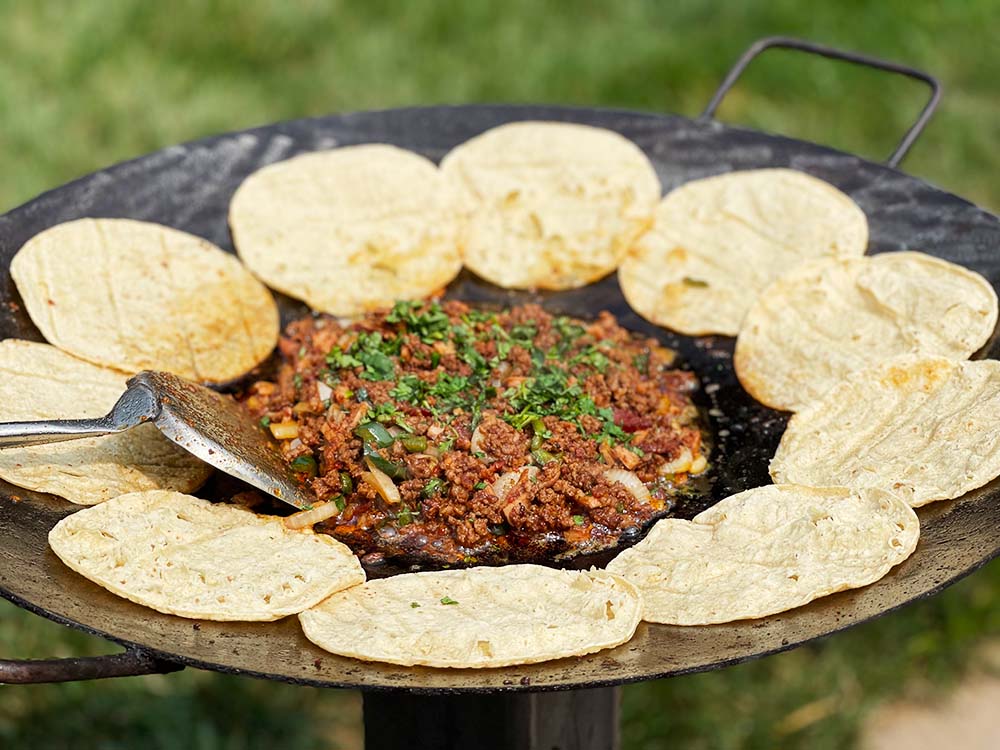Have you heard of a skottle? No, not Skittles and not Scuttle — the bird from The Little Mermaid. The skottle. A humble, yet almost limitlessly multifaceted apparatus for cooking just about anything in the outdoors.

What Is a Skottle Grill Anyways?
A skottle is a broad, circular cooking utensil. It has a convex, slightly domed shape and is typically made of cast iron. Think heavy, hardy, indestructible. If you can cook it in a pan, skillet, or on a grill, it can be cooked on a skottle.
Skottles disperse heat similar to a wok. The center of the skottle grill — and the lowest point, closest to the direct heat — is the hottest. The heat dissipates as it moves outwards from that center point. That means as your food begins to cook sufficiently you can move it towards the edges of the skottle and throw new food in the middle, or shift uncooked parts of the dish towards the center.
The original skottle consisted solely of this round wok-like piece of cookware. However, modern skottles popular amongst the overlanding community include updated designs and features.
While there aren’t many skottle grills on the market, the most popular ones include features like adjustable tripod legs, propane burners, and built-in support for a single-pound propane tank (like the widely recognized Coleman green cylinder propane tanks) or a similar isobutane burner.

The skottle grill has made it big amongst overlanders and outdoor enthusiasts who have the room to carry extra weight. These things aren’t made for backpackers. They generally weigh in around 20-25lbs (the new LavaBox "Skwok" weighs 12lbs)

However, it’s easy to see why they’ve been such a hit amongst overlanders and full time van/RV-lifers. The skottle grill has that “wow” effect and, although the options on the market today are far from compact camping gear, it is still a single item of camp cookware capable of replacing all your other pots and pans.
The skottle looks undeniably rad and will have nearby campers trying to inspect what the heck you’re cooking on. But there’s even more to this humble, utilitarian cooking instrument than meets the eye.

From Farm Equipment to Overland Grill: History of the Skottle
You may be familiar with the skottle as an overlanding grill, but did you know it was originally a component of farming equipment?
Farmers in South Africa are responsible for creating the grills that turned into today’s skottles.
Working with what they had, the farmers repurposed harrow discs used to till the fields, as grills to cook on. These crafty farmers would build woodburning fires and use the harrow discs as hot plates to power a traditional South African ‘Braai’ (an Afrikaans word for ‘barbecue’ or ‘grill’) in the fields.
We like to think they washed the discs before using them to cook their meats… But there’s no record of whether or not that was the case. I guess a little dirt doesn’t hurt.
Modern History: The Skottle as an Overlanding Grill
By the 1940s and 1950s, the public caught wind of the skottle and it became more than a makeshift grill for use in the fields.
The popular home and garden brand, CADAC (Commercial and Domestic Appliance Company) — now owned by leaders in nomadic living appliance design, Dometic — also hails from South Africa. The heritage brand, founded in Johannesburg in 1948, takes credit for first placing the harrow disc-inspired skottle atop a gas cylinder to achieve the modern skottle design.
As the skottle evolved to grow collapsible legs, adopt anti-stick enamel coatings, and continue iterating over the years, it made its way to Europe (and eventually the good old U.S. of A.) where it was eaten up by campers hungry for a convenient cooking solution.
What’s Next for the Humble Skottle Grill?
The rest is history still being written.
The original skottle design adopted from farming equipment in South Africa remains the status quo. Why fix something that isn’t broken? That said, innovators will always innovate and while this versatile piece of kit is based on a bulletproof foundation, it has so much potential to add to…
So much so, that we couldn’t help but tinker with it ourselves. The tinkering elves over here at the LavaBox headquarters have been up to something big. Something you’ve been asking for for quite some time. And yes, if you must ask again or haven’t heard, it is a skottle of our own: The SKWOK.
But as with all things we do, we do it with a LavaBox flare that we promise has upped the ante and leveled up an already great piece of gear. Check out the new Skwok HERE!



